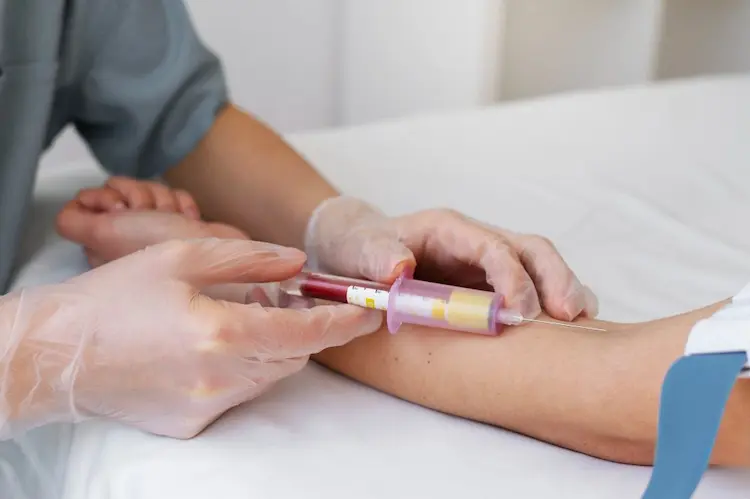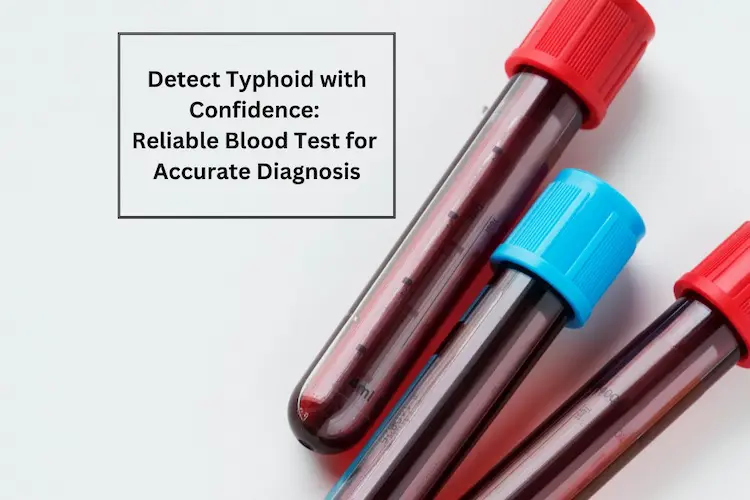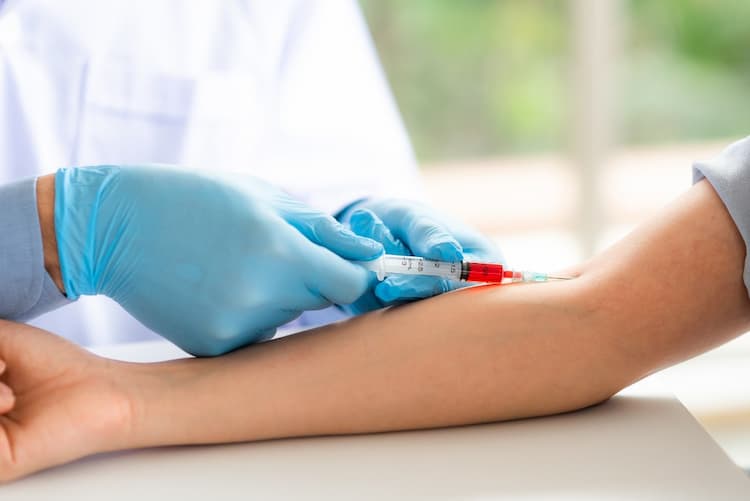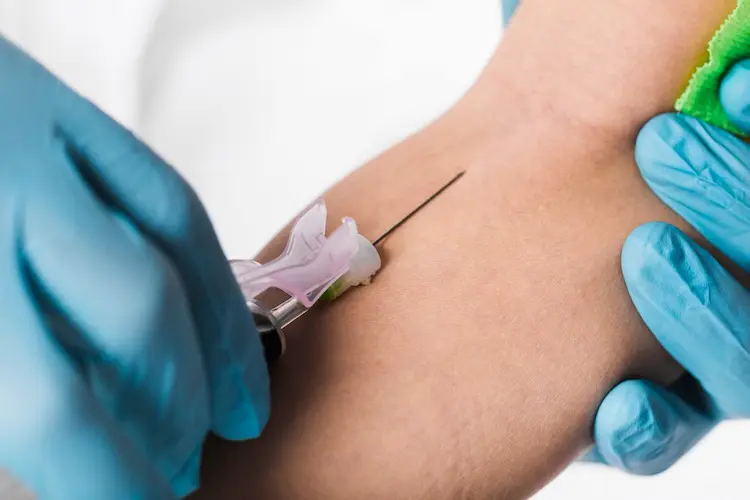Widal Test - Introduction, Principle, and Procedure

Medically Reviewed By
Dr. Ragiinii Sharma
Written By Prekshi Garg
on Dec 8, 2022
Last Edit Made By Prekshi Garg
on Mar 18, 2024

The Widal test is a serological test used to diagnose enteric or typhoid fever. The enteric fever is caused by a gram-negative bacteria known as Salmonella enterica, which is mainly found in the intestine of man. Widal test means a test to detect these specific antibodies in the serum sample of patients suffering from typhoid. When a person is infected, Salmonella possesses O antigen on their cell wall and H antigen on their flagella. A widal test procedure is done to determine these antibodies, which can be detected in the patient's serum after six days of fever or infection.
What is measured by the Widal test?
The Widal test is also known as the Typhoid test and the enteric fever test, which is done to analyze the titres of antibodies against the bacteria that is the primary cause of enteric fever. Typhoid is acquired when a person consumes food or water contaminated by the faeces of an infected person recovering from the disease. The interval between exposure to an infection and the appearance of the first symptoms of enteric fever is six to thirty days. Paratyphoid fever is also similar to typhoid one but is less severe than it. When you visit your doctor after experiencing the symptoms, he will recommend a test; a Widal test is used to detect antibodies in a blood sample against the two antigens that are O and H of the Salmonella enterica. Antibodies or agglutinins refer to the visibility of clumping of particles when they have antigens and which mix with the antibody under specific conditions for the reaction of antigen and antibody. When a test is used for the diagnosis of typhoid and is processed on a slide, it is termed a slide agglutination test, and when carried out in a test tube, it is termed a tube agglutination test. Tube agglutination test is more preferred to slide test for the confirmation of the titres. The antigens that are used are H and O antigens . Widal test should be done after the week of the infection because the antibody testing against O and H antigens begins to appear in serum at the end of the first week of fever. It is devised to perform the test with two blood samples within the interval of seven to ten days.
What is the main Widal test principle and its normal range?
The widal test principle is that if a specific antibody is present in the result, it will react with a particular antigen and show visible clumping on the test card. When a person consumes food contaminated with Salmonella, bacteria enter the body as an antigen. After reaching a person's digestive system, their immunity creates antibodies against those antigens, leading to antigens agglutinating, and then typhoid fever is detected. The widal test detects the antibodies a person's body has made because of a particular bacteria. If you have typhoid fever, your blood will possess antibodies that will react and agglutinate salmonella antigens in an agglutination test. The Widal test is positive or negative, and if a person has a widal test positive, then it means they are detected with thyroid fever.
Who should get a Widal test?
Typhoid or enteric fever is an acute and life-threatening fever causing illness and can be transmitted by taking food or else water that has been contaminated with the faeces of a person who has been infected with this bacteria. One of the reasons a person should go for the widal test procedure is if they have been exposed to someone with thyroid fever and are unsure about their immunity status. Another reason to go for the test is if you have travelled outside your country and think you are at great risk.
What is typhoid fever and its Symptoms?
According to WHO estimates, typhoid fever's global disease burden is at 10 to 20 million cases annually, leading to 126 000 to 161000 deaths annually. Typhoid risk is higher in people with limited access to safe water and adequate sanitation. People who are more prone to it are those of Poor communities and vulnerable groups, including children. Typhoid is a life-threatening infection that spreads through contaminated food or water. Once the bacteria enter the body by eating or drinking, they multiply and spread into the bloodstream. To determine the condition doctor takes the Widal test, and if the test shows a positive result, you have typhoid, and early detection of typhoid help to treat it effectively. Typhoid got this name from a high-level fever that can last for weeks if ignored and is left untreated and often gets progressive and can be worsened over a few days. Symptoms of typhoid fever that a person should keep in mind are:
- Headache.
- Chills.
- Loss of appetite.
- Abdominal pain.
- Rash or faint pink spots on the chest or stomach.
- Cough.
- Muscle aches.
- Nausea or vomiting.
- Diarrhea or constipation.
How can children get typhoid fever?
Children may get typhoid infections because of their developing immune systems. They may catch the infection easily if they are unaware of all preventive measures. However, typhoid affects children less in comparison to adults, but they can get infected by an infected person. It is best for them to avoid consuming street food served in the open and made of unhygienic ingredients. Children can get infected easily when they consume food or drink handled by an individual who already has typhoid fever or is a carrier of the bacteria, even if they have a widal test normal range. Some symptoms of typhoid in children are:
- Prolonged fever
- Fatigue
- Headache
- Nausea
- Abdominal pain
- Constipation
- Diarrhea
- Rashes
- Vomiting
- Stomach ache
- Loss of appetite
What are the Stages of typhoid fever?
A person can develop symptoms of typhoid fever in four stages, and it is necessary to go for the test as the Widal test means to get detected on time and to start the early treatment. Early treatment can prevent you from progressing to later severe stages:
Stage 1
At this stage, a person will get typhoid symptoms between 5 to 14 days after getting infected. The primary symptom is a fever that gets higher over a few days, called stepwise, and at this stage, the bacteria move into your blood.
Stage 2
At this stage, it will be the second week of fever, in which bacteria start to multiply in a part of your immune system. You will start experiencing abdominal pains and other stomach-related problems like constipation or diarrhoea. You might experience red rashes or small dots also on your skin.
Stage 3
If a person does not get the widal test used for diagnosis of typhoid and is not treated with antibiotics, they can reach this stage. The bacteria can cause severe damage in the third week after symptoms develop. A few people get serious complications like internal bleeding and inflammation in the brain too.
Stage 4
It is the stage in which most people begin recovery. A person's high fever starts to come down. At this stage, even if a person feels better, they may still be contagious.
A widal test is done to detect typhoid and paratyphoid fever, collectively named enteric fever, caused by consuming food or water contaminated by Salmonella bacteria. Widal test positive means that a person has an enteric fever for typhi bacterial infection. If a person experiences an early stage of disease symptoms, including abdominal pain, fever and a normal feeling of being unwell, then they must get the Widal test done immediately to determine the cause and to get treatment on time. If left untreated, typhoid can lead to intestinal bleeding and perforation. This can even become severe abdominal pain, nausea, vomiting or, in the worst cases, sepsis.
What are the causes of typhoid?
Widal test positive means you have typhoid, and typhoid is caused when the bacteria S.typhi spreads through food, drinks as well as drinking water that is contaminated with the infected faecal matter. If the water is contaminated, washing fruits and veggies with it can also spread it. Some people can have thyroid without showing any symptoms, and the disease can appear again in a few cases. People who show widal test positive may not be allowed to work with kids or older adults until the test shows negative results after recovery.
How to Diagnose typhoid?
When you experience one of the above-listed symptoms, you must visit your doctor, who will diagnose typhoid based on your travel history and lab test. A widal test is used for the diagnosis of typhoid. A doctor may also want to know more details about your medications, vaccinations that you received and whether you came into contact with unclean water or food. They will also give you a physical exam and listen to your heart and lungs. Widal test means a test to identify, diagnose and monitor the fever and other salmonella infections,
What is the treatment of typhoid?
The only best treatment for typhoid is taking antibiotics prescribed by the doctor after taking the Widal test. Typhoid patients should try to stay hydrated by drinking sufficient water. A doctor may advise patients to have fluids, and electrolytes may be given into the vein, or they may be asked to drink water with electrolytes packets in it.
What is the Progression of typhoid?
Typhoid fever symptoms usually improve in two to four weeks with treatment, and the outcome is great with early widal tests and treatment. The condition can even become poor if complications develop, and symptoms can return if treatment is left incomplete. Some possible complications are:
- Intestinal haemorrhage
- Intestinal perforation
- Kidney failure
- Peritonitis
How to Prevent yourself and your children from typhoid fever?
Typhoid is a life-threatening bacterial infection that can affect many organs in the body if left untreated. The fever is common in areas that are poorly sanitized and have limited access to clean water. The condition is highly contagious as people with Widal test positive can spread it if a healthy person has been contaminated with infected faeces or urine. Two vaccines are available for typhoid fever; thus, take them to stay protected. To prevent Typhoid fever, you should follow
- Good hygiene and sanitation including hand washing and ensuring the drinking of clean water.
- Food should also be prepared carefully, and leftover food must be reheated properly before being eaten.
- You must wash your teeth with boiling water and avoid swallowing shower water.
- Avoid ordering drinks with ice unless ice is made of boiling water.
FAQs
- How long does typhoid last?
Typhoid fever lasts for about 7 to 10 days when started soon after symptoms start and done with a widal test procedure. If you have complications, it can take longer than that to recover fully.
- What is the normal range of the Widal test?
The normal range is widal test positive or negative.
- What are the preparations to be done for the Widal test?
No preparations are needed, or no fasting is required for the Widal test.
- What to expect after the Widal test?
Your doctor will collect the blood sample for the Widal test procedure, and that sample will be sent to the laboratory. It is sent for processing and testing. When the reports are ready, the doctor will share them with you, which will be positive or negative.
- What does a widal test positive means?
Widal test positive means that you have typhoid fever.
- What are O and H in the widal test?
O is considered lgM somatic and appears first, representing the initial response to acute typhoid fever. In the widal test, H is considered an IgG flagellar that usually develops more slowly but persists for longer.
- For how long a person carries typhoid germs?
Time taken for a person to carry typhoid gems depends on stages, from a number of days to years; just about 3 percent of cases become lifelong carriers of the germs.
Conclusion
Typhoid fever is a life-threatening infection that spreads through contaminated water or food. Even if the symptoms disappear, people may still carry typhoid bacteria which can spread to many others. Gin through a widal test can help you to treat it well. The Widal test is used for the diagnosis of typhoid at its early stages and to treat it well. People who do not maintain good hygiene are more prone to this bacteria, which is the main culprit of typhoid. If you have a fever that increases with each passing day, you might have typhoid. Visit your doctor to get tested, and the widal test positive means you have typhoid, which should be treated as soon as possible. It is vital to note that typhoid is a serious condition, and you must inform your doctor about early symptoms.
Leave a comment
1 Comments
Benard Paulina
Nov 9, 2023 at 9:26 AM.
I'm pleased with this article... It gave me what I was searching for
Myhealth Team
Nov 17, 2023 at 12:02 PM.
We glad to hear that you found the information helpful! If you have any more questions or if there's anything else I can assist you with, feel free to let me know.



